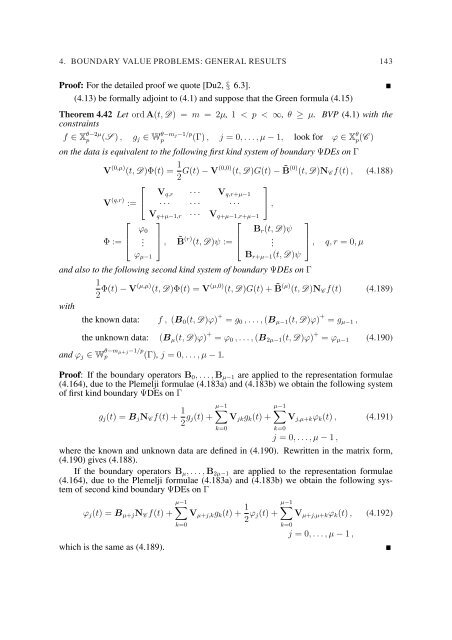EQUATIONS OF ELASTIC HYPERSURFACES
EQUATIONS OF ELASTIC HYPERSURFACES
EQUATIONS OF ELASTIC HYPERSURFACES
Create successful ePaper yourself
Turn your PDF publications into a flip-book with our unique Google optimized e-Paper software.
4. BOUNDARY VALUE PROBLEMS: GENERAL RESULTS 143<br />
Proof: For the detailed proof we quote [Du2, § 6.3].<br />
(4.13) be formally adjoint to (4.1) and suppose that the Green formula (4.15)<br />
Theorem 4.42 Let ord A(t, D) = m = 2µ, 1 < p < ∞, θ ≥ µ. BVP (4.1) with the<br />
constraints<br />
f ∈ X θ−2µ<br />
p (S ) , g j ∈ W θ−m j−1/p<br />
p (Γ) , j = 0, . . . , µ − 1, look for ϕ ∈ X θ p(C )<br />
on the data is equivalent to the following first kind system of boundary ΨDEs on Γ<br />
V (0,µ) (t, D)Φ(t) = 1 2 G(t) − V(0,0) (t, D)G(t) − ˜B (0) (t, D)N C f(t) , (4.188)<br />
⎡<br />
V (q,r) := ⎣<br />
Φ :=<br />
⎡<br />
⎢<br />
⎣<br />
⎤<br />
V q,r · · · V q,r+µ−1<br />
· · · · · · · · · ⎦ ,<br />
V q+µ−1,r · · · V q+µ−1,r+µ−1<br />
⎤<br />
ϕ 0<br />
⎥<br />
.<br />
ϕ µ−1<br />
⎦ , ˜B (r) (t, D)ψ :=<br />
⎡<br />
⎢<br />
⎣<br />
B r (t, D)ψ<br />
.<br />
B r+µ−1 (t, D)ψ<br />
⎤<br />
⎥<br />
⎦ , q, r = 0, µ<br />
and also to the following second kind system of boundary ΨDEs on Γ<br />
1<br />
2 Φ(t) − V(µ,µ) (t, D)Φ(t) = V (µ,0) (t, D)G(t) + ˜B (µ) (t, D)N C f(t) (4.189)<br />
with<br />
the known data: f , (B 0 (t, D)ϕ) + = g 0 , . . . , (B µ−1 (t, D)ϕ) + = g µ−1 ,<br />
the unknown data: (B µ (t, D)ϕ) + = ϕ 0 , . . . , (B 2µ−1 (t, D)ϕ) + = ϕ µ−1 (4.190)<br />
and ϕ j ∈ W θ−m µ+j−1/p<br />
p (Γ), j = 0, . . . , µ − 1.<br />
Proof: If the boundary operators B 0 , . . . , B µ−1 are applied to the representation formulae<br />
(4.164), due to the Plemelji formulae (4.183a) and (4.183b) we obtain the following system<br />
of first kind boundary ΨDEs on Γ<br />
g j (t) = B j N C f(t) + 1 µ−1<br />
µ−1<br />
2 g ∑ ∑<br />
j(t) + V jk g k (t) + V j,µ+k ϕ k (t) , (4.191)<br />
k=0<br />
k=0<br />
j = 0, . . . , µ − 1 ,<br />
where the known and unknown data are defined in (4.190). Rewritten in the matrix form,<br />
(4.190) gives (4.188).<br />
If the boundary operators B µ , . . . , B 2µ−1 are applied to the representation formulae<br />
(4.164), due to the Plemelji formulae (4.183a) and (4.183b) we obtain the following system<br />
of second kind boundary ΨDEs on Γ<br />
µ−1<br />
∑<br />
ϕ j (t) = B µ+j N C f(t) + V µ+j,k g k (t) + 1 µ−1<br />
2 ϕ ∑<br />
j(t) + V µ+j,µ+k ϕ k (t) , (4.192)<br />
which is the same as (4.189).<br />
k=0<br />
k=0<br />
j = 0, . . . , µ − 1 ,

















